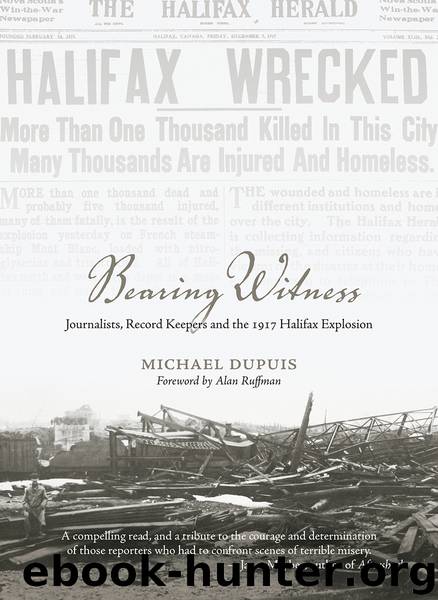Bearing Witness by Michael DuPuis

Author:Michael DuPuis
Language: eng
Format: epub
Publisher: Fernwood Publishing
Published: 2017-03-13T04:00:00+00:00
Chapter 4
Visiting American Journalists and the Aftermath
But words are things, and a small drop of ink, falling like dew upon a thought, produces that which makes thousands, perhaps, millions think.
— Lord Byron, Don Juan
During the early hours of 8 December 1917 five American journalists arrived in Halifax on the first Boston relief train.1 They were Anthony Philpott, Boston Daily Globe, Jerome Keating, Boston Herald-Journal, Roy Atkinson, Boston Post, Richard Sears, Boston American, and Richard Simpson, Associated Press. Within hours Prime Minister Borden arranged accommodation for them at the Halifax Club; some remained in Halifax for up to a week.2 Given they were Boston-based colleagues, travelled on the same relief train for two days, were accommodated collectively and shared the same assignment, they in fact constituted a press club. On 9 December internationally famous photojournalist and war correspondent James “Jimmy” Hare of Leslie’s Weekly arrived in Halifax from Long Island, New York, and the next day a Providence Journal/Bulletin staff correspondent arrived on board the Rhode Island relief train.
Why so many Boston journalists? First, Boston was the nearest major American metropolis to the disaster. Second, Boston’s daily newspapers had large enough budgets to send reporters on assignment to Halifax. Third, the ties between Massachusetts and Nova Scotia were profound and filial with approximately 45,000 Nova Scotians, excluding their children, living in Massachusetts in 1917.3 Readers in Boston and Massachusetts therefore had a special interest in the Explosion and the city editors of the Boston Globe, Post, Herald-Journal and bureau chief of Boston AP capitalized on this knowledge by providing credential letters for their correspondents to the public safety and state guard commission on the relief train.4 Hare was sent to Halifax by Leslie’s to obtain material for photo-stories, and the Providence Journal/Bulletin’s reporter was sent to provide news of the disaster and learn the fate of 150 families in Halifax with relatives in Rhode Island.5
Besides the Boston reporters, Hare and the Providence Journal/Bulletin correspondent, no other known American journalists were sent to Halifax to cover the disaster’s aftermath.6 Reasons for this included the challenge of reaching Halifax by train due to severe winter weather conditions in Nova Scotia between 6 and 10 December, low staff levels and financial impediments for many newspapers while the war was in progress, and the presence in Halifax of Associated Press reporter Richard Simpson, whose despatches could be taken off the AP wire by most American newspapers.7
Anthony Philpott, Boston Globe
Born in Ireland in November 1862, Anthony Philpott was a member of the Globe for fifty-nine years, serving as reporter, desk editor, art editor and feature writer. Prior to joining the editorial staff of the paper in 1893, he worked on dailies in Philadelphia, Chicago and New York. For his fundraising efforts for Belgian relief during World War I he was decorated by King Albert of Belgium. Philpott died “in harness” at age ninety on 29 February 1952.1
While en route to Halifax on 6 December, fifty-five year-old Philpott wired two despatches to the Globe; once in Halifax he sent five more.
Download
This site does not store any files on its server. We only index and link to content provided by other sites. Please contact the content providers to delete copyright contents if any and email us, we'll remove relevant links or contents immediately.
| Anthropology | Archaeology |
| Philosophy | Politics & Government |
| Social Sciences | Sociology |
| Women's Studies |
Cecilia; Or, Memoirs of an Heiress — Volume 1 by Fanny Burney(32413)
Cecilia; Or, Memoirs of an Heiress — Volume 3 by Fanny Burney(31823)
Cecilia; Or, Memoirs of an Heiress — Volume 2 by Fanny Burney(31804)
The Great Music City by Andrea Baker(31249)
We're Going to Need More Wine by Gabrielle Union(18951)
All the Missing Girls by Megan Miranda(15494)
Pimp by Iceberg Slim(14320)
Bombshells: Glamour Girls of a Lifetime by Sullivan Steve(13952)
Talking to Strangers by Malcolm Gladwell(13185)
Norse Mythology by Gaiman Neil(13171)
Fifty Shades Freed by E L James(13145)
For the Love of Europe by Rick Steves(12646)
Mindhunter: Inside the FBI's Elite Serial Crime Unit by John E. Douglas & Mark Olshaker(9163)
Crazy Rich Asians by Kevin Kwan(9147)
The Lost Art of Listening by Michael P. Nichols(7388)
Enlightenment Now: The Case for Reason, Science, Humanism, and Progress by Steven Pinker(7165)
The Four Agreements by Don Miguel Ruiz(6597)
Bad Blood by John Carreyrou(6519)
Weapons of Math Destruction by Cathy O'Neil(6116)
